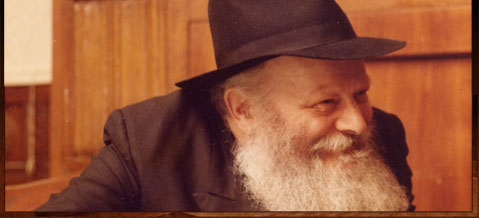Mrs. Sara Nachshon
My love for the Land of Israel comes from my parents. They moved here when they were young – first to Tel Aviv, back when it was still small, then to a little farm in Kfar Hasidim – and they nurtured our connection to the land.
My family knew very li
ttle about Chabad. After Baruch and I married, he wanted to go see the Rebbe. Personally, I felt my place was in Israel, but I went along with my husband. In 1964, we traveled to New York by ship, and when they finally met, the Rebbe encouraged my husband to attend art school in New York, which led to us living there for a year.
About a month after arriving, I had an audience with the Rebbe; I was pregnant at the time, and I wanted to receive his blessing ahead of the birth.
He spoke to me like a father to his child. He asked me many questions, such as whether I had friends in New York, and what the doctors had said about my pregnancy. He even gave me the names of some local women with whom I could speak Hebrew – women I have remained friends with until today. I had known nothing about the Rebbe, but after that first meeting, I felt very close to him.
After a year in Crown Heights, the Rebbe told us that our place was in Israel.
“Where?” we asked.
“Wherever you want,” he replied.
So, we went back to Israel, and a few years later a great miracle happened – the 1967 Six Day War. In just six days, we won back the Old City of Jerusalem, along with Hebron, Shechem, and other parts of Israel.
In 1929, the Jewish community of Hebron had been destroyed in a massacre committed by the local Arabs, and now that we had reconquered the holy city, we had every right to move back. But Israel’s government forbade Jews from moving there. In 1968, they forced a group of Jews to leave an Arab-owned hotel in Hebron, but eventually they allowed a few families to take up residence in a nearby police station. Our family was given one room. When we asked the Rebbe about this idea, he gave us his blessing.
After three years, the government built a Jewish town near Hebron, which they called Kiryat Arba, and we were instructed to leave the police station and move there.
We lived in Kiryat Arba for a few years but, despite the government’s objections, we still very much wanted to live in Hebron proper. It is one of the four holy cities in Israel; our forefathers and mothers lived and were buried there; King David reigned there; it belongs to the Jewish people. It was immoral that the Arabs could massacre our people and then dislodge us from our own property. If their presence on the lands they stole from us went unchallenged, their appetite would continue to grow, and there would be further victims.
By then, we had also made a brit in Hebron – it was the first since the 1929 massacre, and we named our son after the city, Shneur Chevron. In 1975, when our baby Avraham Yedidyah passed away in a crib death, I carried him to the old Jewish cemetery – which lay destroyed and desecrated – to lay him to rest there. I waited for hours until the authorities finally let me through. It was history as a circle: The Jewish connection to Hebron began when Abraham buried Sarah there, and on that day another Sarah buried her Abraham there.
So after all this, in 1979, we decided that we would go back and live in Hebron, no matter what. One night, a group of fifteen women and thirty-five children drove up to the old Beit Hadassah hospital of Hebron, which was built in 1893, the first modern Jewish hospital in Israel.
There was a soldier standing in front of the hospital, so we went around the back, cut some wires that the army had placed around the building, took a ladder and jumped inside. Once we had cleaned out a space for us to stay and put down some mattresses and supplies, we began to sing the song “Veshavu Banim Ligvulam – the children shall return to their borders.”
The army did not forcibly remove us, but they did not let anything or anyone else enter. The old hospital building had no electricity or running water, and it was only after a vote in the Knesset that an army truck was allowed to come every few days to replenish our water supply. After three months, the government decided that if we sent our children off to school every day, they would be allowed to come back in afterward. On Shabbat, one of our husbands could come and make kiddush. Other husbands, along with a group of yeshivah boys, would also come by after the Friday night prayers at the Cave of Machpelah to sing us Shabbat songs from outside the building, before going back to their homes in Kiryat Arba.
After six months in Beit Hadassah without seeing any progress, I wrote a letter to the Rebbe outlining the situation and requesting his advice on what I should do. We could not receive mail, but three weeks later a group of Chabad women came, bringing with them a recording of the Rebbe at a public gathering. That night, we listened to the recording, and to my amazement, the Rebbe was speaking about me:
“Today, I received a letter from a woman who has been sitting in Hebron, with small children, for several months,” said the Rebbe, briefly relating our story.
Outraged, he went on to say that it was the Jewish authorities themselves who were stopping other Jews from coming into Beit Hadassah. And this, he decried, was even though “everyone acknowledges – even the Arabs – that this building belongs to Jews!”
“What can I answer her?” asked the Rebbe.
He went on to discuss the story of the daughters of Tzlafchad, who went to Moses after the passing of their father, asking to inherit their family’s portion of the Land of Israel. Moses asked G-d what to do, and He said that since they had such a love for the Land of Israel, they would receive a portion of their own. Hearing the Rebbe make this connection gave us the strength to carry on.
One Friday night a few months later, terrorists attacked a group of yeshivah students as they stood outside singing Shabbat songs to us. Six boys were killed, and more were wounded. As a result, the government decided to let us stay, and to rebuild the hospital building so that our families could live in it. After this, more people were able to start settlements in the rest of Judea and Samaria, and Jewish people have been allowed to live in Hebron ever since.
Years later, I began sending my daughters to a Chabad school in Jerusalem, but this was very difficult because they had to take two buses to get there. I started to wonder whether moving to Jerusalem would be better for their education, and I wrote a long letter to the Rebbe about it.
“You came to live in Hebron – what changed?” the Rebbe replied. We had decided to live in Hebron despite all the challenges, so G-d would give us the power to bring up our children here too. From that line that the Rebbe wrote to me, I have stayed here until this day.
Mrs. Sara Nachshon is an activist and one of the founding members of the Jewish settlement in Hebron and Kiryat Arba. She was interviewed in July 2022.





